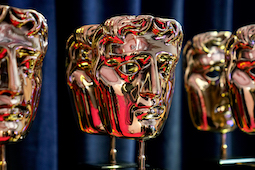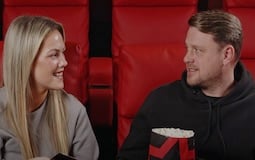
Forth, Eorlingas! We're returning to Middle-earth this December in the visually arresting fantasy epic The Lord of the Rings: The War of the Rohirrim.
Even if you're a die-hard fan of the books and the accompanying films, you've never seen the lore rendered quite like this. Here's why.
1. It's the first Lord of the Rings movie to be rendered as anime
There have been animated Lord of the Rings adaptations before, notably, the 1978 take directed by Ralph Bakshi. The War of the Rohirrim, however, is different. As revealed at the 2023 Annecy Film Festival, the movie utilised performance capture effects, already used by Andy Serkis to portray Gollum, which translated into 3D animation via a game engine to map out camera movements and landscapes. The finished film was finally rendered as arresting 2D visuals.
The end result intentionally owes a debt to the celebrated anime tales from Studio Ghibli, in particular those of studio co-creator Hayao Miyazaki. Key reference points included Kurosawa's 1997 fantasy epic Princess Mononoke. When it comes to the scope of the battle sequences, the filmmakers have also acknowledged the influence of master Japanese filmmaker Akira Kurosawa, responsible for trend-setting masterpieces like Seven Samurai (1955).
"Anime has become a movement overseas," says producer Joseph Chou (via CBR.com). "I'm grateful for the opportunity to produce The Lord of the Rings through animation. We, [director Kenji Kamiyama] and I, all agreed that it was impossible to make it happen, but we created this film together...I hope that not only fans of The Lord of the Rings will enjoy it, but also that they will watch it as a Japanese animated film."
2. It's directed by someone other than Peter Jackson
In the wake of Ralph Bakshi's 1978 animation, director Peter Jackson achieved the impossible with his live-action Lord of the Rings trilogy, translating impossibly dense and nuanced lore into the sort of seat-shaking, all-encompassing cinema that viewers hadn't experienced for decades. It was arguably the first fantasy series to be rendered on such an expansive scale, doing justice to both character nuance and broad strokes action sequences while showing relative fidelity to the much-loved source material.
Although Jackson directed the less well-regarded Hobbit trilogy, he's now stepped aside in favour of director Kenji Kamiyama. The latter is a noted anime director whose career stretches back nearly 40 years and encompasses work on the groundbreaking likes of Akira (1988) and Studio Ghibli's Kiki's Delivery Service (2002).
Kamiyama made his directorial debut in 2002 with Mini Pato, and he's also helmed Ghost in the Shell: Stand Alone Complex and Ghost in the Shell: S.A.C. 2nd GIG. Kamiyama and Shinji Aramaki directed Blade Runner: Black Lotus, an anime for Adult Swim and the anime distributor Crunchyroll, which was released in 2021 and 2022.
Kamiyama recalls (via CBR.com): "When I saw the live-action Lord of the Rings trilogy 25 years ago, I was left with the impression that it was an amazing movie, and I felt that I had to protect that impression [with this film] at all costs...I wanted people to have that experience again. That's why I ended up drawing it in the traditional Japanese animation style."
Kamiyama adds: "I loved The Lord of the Rings, including The Hobbit, and watched it as a fan. I thought it would be rare to have the chance to make it into a movie."
3. It's the first feature-length Lord of the Rings movie to be adapted from the appendices
Lord of the Rings scriptwriter and The War of the Rohirrim producer Philippa Boyens insisted that any new Lord of the Rings project centre around the rich horse-riding legacy of Rohan. To that end, The War of the Rohirrim adapts three important paragraphs from Appendix A at the end of Tolkien's The Return of the King, specifically the 'House of Eorl' section.
The War of the Rohirrim is therefore set 183 years before the events of Jackson's live-action Lord of the Rings trilogy and tells the story of the monumental Rohan king Helm Hammerhand. Helm and his tomboyish daughter Hèra are compelled to protect their kingdom from an invasion of dunlendings, led by the vengeful Wulf.
As Helm's story unfolds, we learn how his story inspired the name of the iconic fortress Helm's Deep, the site of the pivotal climactic battle in Jackson's film The Lord of the Rings: The Two Towers (2002).
4. It's the first Lord of the Rings film to cross the worlds of Middle-earth and Succession
That's because the iron-headed and tempestuous Helm Hammerhand is portrayed by everyone's favorite shouty Scotsman, Brian Cox. Forever immortalised as the ruthless business magnate Logan Roy in the acclaimed series Succession, Cox will now lend his booming vocal register to the role of the legendary Rohan leader.
Amusingly, Cox recently admitted that he "didn't really know Tolkein" before signing onto this movie. Nevertheless, he's surely the perfect person to convey Hammerhand's imposing, irascible yet noble sense of intent. Cox is joined by newcomer Gaia Wise as Hera, and Skins and Snowpiercer star Luke Pasqualino as Wulf.
Actor Miranda Otto is said to be reprising her role as Eowyn, daughter of Rohan leader Theoden. Otto appeared as the character in live-action form in The Two Towers and The Return of the King (2003) while Theoden was played by the late Bernard Hill. In this movie, she's credited as our narrator.
Additionally, the movie is said to be making use of archival audio of the late Christopher Lee as Saruman.
5. It isn't scored by Lord of the Rings regular Howard Shore
The 1978 Lord of the Rings movie was scored by the noted Leonard Rosenman and while the score is highly regarded by some, it cannot compare to the monumental scores composed by Howard Shore for Peter Jackson's live-action trilogy.
One cannot separate the Lord of the Rings movies from the shimmering tapestry of music composed so beautifully by Shore. The composer's multifaceted work ran the gamut of stylistic influences from rural Irish pennywhistles to subtle Elvish invocations and seat-shaking orchestral action passages, encompassing nearly eight hours of music across three films (including the extended cuts) and imbuing more profound emotional ballast into the world of Middle-earth.
Shore won an Oscar for his first and third scores in the series before reuniting with Peter Jackson on the Hobbit trilogy. Shore has now given way to Stephen Gallagher, the music editor on the Hobbit films, and who now steps up as a fully-fledged composer in his own right.
Gallagher is said to be reprising Shore's stirring Rohan theme, first introduced in The Two Towers. Specialty instruments are set to include wind arrangements from the New Zealand-based Stroms Studios, taiko drums from Japan and crumhorn wind instruments hailing from the German Renaissance period. Expect the music to be a rich part of the emotional fabric as it was during the Jackson/Shore collaboration.
The Lord of the Rings: The War of the Rohirrim is released on December 13th. Book your tickets via the link below.














.jpg)
.png)






